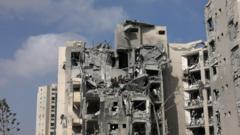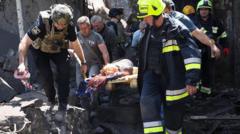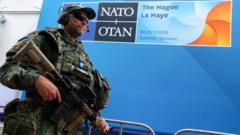In a harrowing account of loss, an 80-year-old woman becomes a victim of the escalating drone warfare in Ukraine, highlighting the personal tragedies woven into the broader conflict.
Tragedy from Above: The Impact of Drone Warfare on Ukrainian Lives

Tragedy from Above: The Impact of Drone Warfare on Ukrainian Lives
As drone strikes intensify in Ukraine, the personal stories of loss and survival emerge, showcasing the devastating human toll of the conflict.
Mykola Zarutskyi’s life changed forever on March 22 when he lost his mother, Liudmyla Zarutska, after a Russian Shahed drone struck her home on the left bank of the Dnipro River in Kyiv. The 80-year-old, who was preparing to retire soon from her job at the Palace of Children and Youth, had spent her last day focused on her impending transition into a peaceful retired life. As she watched the evening news that fateful night, she discussed plans with Mykola, who lived near the frontlines in Sumy, but insisted he should stay put to prepare for his new job in Kyiv the following week. This insistence, which likely saved his life, was the last fleeting moment of connection before tragedy struck.
Zarutska had demonstrated resilience throughout her life. Born in the immediate aftermath of World War II, she experienced hardship but flourished in an era of reconstruction. In the 1960s, she settled into a new apartment complex that provided a nurturing environment for her son. Mykola excelled in sports and later transitioned his career into the agricultural sector, while Liudmyla filled their home with traditional culinary creations and memories stitched into her handmade objects.
As the conflict escalates, the frequency of drone strikes has dramatically intensified. Reports indicate that air raid alerts have become an almost daily occurrence. For residents like Liudmyla, these technological threats represent a new kind of warfare that adds to the psychological burden of living under constant uncertainty. The realities of siege warfare now extend beyond the frontlines, reaching deep into the homes of ordinary citizens across Ukraine, where the sound of drones brings with it the potential for sudden loss and heartache.
While the government aims to negotiate potential cease-fires, the atmosphere among civilians remains tainted by skepticism and anxiety. Zarutskyi’s personal tragedy encapsulates a larger narrative of grief and endurance, compelling communities to confront the side effects of war that touch every aspect of life, even in the heart of a city once vibrant and bustling with 80 years of cherished memories.
Zarutska had demonstrated resilience throughout her life. Born in the immediate aftermath of World War II, she experienced hardship but flourished in an era of reconstruction. In the 1960s, she settled into a new apartment complex that provided a nurturing environment for her son. Mykola excelled in sports and later transitioned his career into the agricultural sector, while Liudmyla filled their home with traditional culinary creations and memories stitched into her handmade objects.
As the conflict escalates, the frequency of drone strikes has dramatically intensified. Reports indicate that air raid alerts have become an almost daily occurrence. For residents like Liudmyla, these technological threats represent a new kind of warfare that adds to the psychological burden of living under constant uncertainty. The realities of siege warfare now extend beyond the frontlines, reaching deep into the homes of ordinary citizens across Ukraine, where the sound of drones brings with it the potential for sudden loss and heartache.
While the government aims to negotiate potential cease-fires, the atmosphere among civilians remains tainted by skepticism and anxiety. Zarutskyi’s personal tragedy encapsulates a larger narrative of grief and endurance, compelling communities to confront the side effects of war that touch every aspect of life, even in the heart of a city once vibrant and bustling with 80 years of cherished memories.























